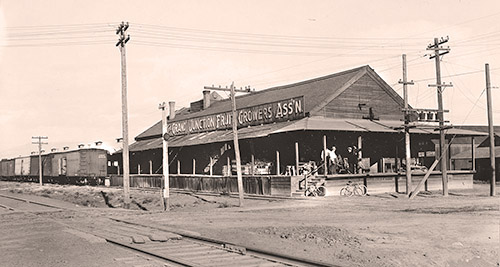Grand Valley Agriculture, early 1900s
[By Kathryn R. Burke | Montrose Mirror | October 28, 2024]
By Joe Zeni and Kathryn R. Burke
In the early 20th century, across the entire Western Slope of Colorado, nothing was more important than agriculture. Railroads, real estate, commercial businesses, and mining all contributed to the local economies, but most people made their livelihoods from growing and selling agricultural products.
The Grand Valley offered the right combination for agricultural prosperity. A warm summer climate, long growing season, rich fertile soil, an abundance of labor, and railroads to transport harvested fruits and vegetables to markets near and far. With a couple of hiccups like insect control and temperature adjustments to address, the towns of Grand Junction, Fruita, and Palisade began to make the best of what the area had to offer.

Office and warehouse of the Grand Junction Fruit Growers Assn., showing iced refrigerator cars waiting to be loaded. 1913
U.S. Bureau of Reclamation 115-JE-111
But they still needed water. Getting irrigation into the Valley was a primary focus of early farmers. Canals were dug off the Grand (later, Colorado) River, sometimes by hand, and served early fruit growers in Palisade. As larger and larger canals were needed for orchards down-river, private groups invested in the equipment needed to build more extensive irrigation systems throughout the Valley. Ultimately, the Federal Government funded the building of a massive dam in DeBeque Canyon, Water and the creation of a Government Highline Canal that provided water to orchards all the way west of Fruita.

Highline Canal ca 1915
As the water flowed into the Valley, hundreds of thousands of fruit trees, predominantly apples, were planted. Fruit was grown, picked, packaged, and shipped to market. Family income increased and the future looked bright. But farming is like the lottery, you never know if you’ll win or lose. Periodic spring freezes and the coddling moth proved to be serious threats. Enterprising locals addressed the issues with a new invention: the smudge pot. And began to use increasingly toxic insect sprays. Both efforts saw only moderate success. In a few years a half million healthy fruit trees were pulled out of the ground in favor of more lucrative field crops like corn, beans, potatoes, grapes, wheat, oats, and hay. In the east Valley, a new fruit tree, peaches replaced the apples.
As the agriculture of the Valley began to diversify, so did the communities. Like-minded growers formed cooperatives and other groups that met their needs. Newer mechanical equipment made farming easier and more productive. Reduced freight rates made shipping products to market more economically viable. Iced refrigerator railway cars kept produce stable so it could travel farther without spoiling. Larger industrial enterprises like canning factories, flour mills, and fruit exchanges soon appeared. In more rural areas of the county, cattle and sheep operations flourished, the animals fed by local farmers in the winter and high mountain open range in the summer.
Although industrialization, and eventuality tourism, became economic mainstays throughout western Colorado, agriculture continues to play an important role Its prosperity even today. Many small farmers have eschewed toxic chemical sprays in favor of companion planting and heirloom seed growing. Grand Junction and the surrounding region host numerous festivals celebrating harvest, wine growing, corn, apples, peaches, lavender—yes, it’s edible—and more. From early spring through the end of the pumpkin latte season, local farmers’ markets supply fresh food to suit every palate. Restaurants support farmers with locally sourced farm-to-table meals for their customers. And the really good news is: Growing and eating fresh food grown on local farms and ranches is not governed by AI (Artifical intelligence); it takes real people doing real work, shoveling, mucking, haying, hoeing, mowing, irrigating, harvesting and getting their ranch and farm boots muddy.
Kathryn R. Burke is an artist, educator, author, and publisher. Visit her website to see more about Cheri Isgreen and other artists. https://kathrynrburke.com/writer/art-artists/
Joe Zeni is a retired education and active historian. His newest book, Promise (available from San Juan Publishing) fells the story of a young who grew up in Grand Junction and later served in the Ambulance Corps in the Balkans during WWI.

